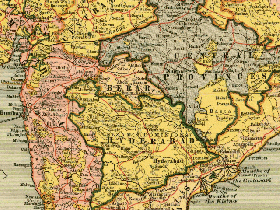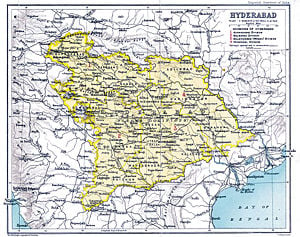Hyderabad State
| |||||||||||||||||||||||||
Hyderābād and Berar pronunciation ▶ (Telugu: హైదరాబాదు, Urdu: حیدر آباد) under the Nizams, was the largest princely state in the erstwhile Indian Empire. The Berar region of present day Vidarbha in Maharashtra was merged with the Central Provinces in 1903, to form Central Provinces and Berar.
Hyderabad state was located in south-central Indian subcontinent from 1724 until 1948, ruled by a hereditary Nizam. During partition of India in 1947, the Nizam of Hyderabad declared his intentions of not joining either newly formed India or Pakistan. Sensing trouble, India launched Operation Polo which resulted in the absorption of Hyderabad into the Indian Union, in 1948.
History
Hyderabad was founded by the Qutb Shahi dynasty of Golconda. In 1686 the Mughal emperor Aurangzeb campaigned in the Deccan to overcome the Marathas and conquer the independent Deccan states. Before the campaign, the Mughals had controlled the northwestern Deccan, including Khandesh and Berar, but Mughal control ended at the Godavari River. Aurangzeb conquered Golconda and Bijapur in 1687, extending Mughal control south of the Krishna River.
The Mughal Empire began to weaken during the reign of Aurangzeb's grandson, Muhammad Shah. A Mughal official, Asif Jah, treacherously defeated a rival Mughal governor to seize control of the empire's southern provinces, declaring himself Nizam-al-Mulk of Hyderabad in 1724. The Mughal emperor, under renewed attack from the Marathas, was unable to prevent it.
The Nizams patronized Islamic art, culture and literature and had a railway system called The Nizam's Government State Railways. Sharia-The Islamic Religious Law Code, was the guiding principle of the Nizams' official machinery.
During the British Raj
The seniormost (21-gun) princely state in British India, Hyderabad was an 82,000 square mile (212,000 km²) region in the Deccan ruled by the Asif Jahi dynasty, who had the title of Nizam and was bestowed the title of His Exalted Highness by the British Empire. The Nizam had a penchant for setting up institutions in the name of the dynasty. He set up schools, colleges, madrasas (Islamic Seminaries) and a University that imparted education in Urdu. Inspired by the elite and prestigious ICS (Indian Civil Service), he started HCS (Hyderabad Civil Service). The pace with which he amassed wealth made him to be the world's richest men in the 1930s, (Time cover story Feb. 22, 1937). Carrying a gift, called Nazrana in the local dialect, in accordance with one's net worth while meeting Nizam was a de facto necessity.
After the British Raj (1947-48)
When India gained independence in 1947, the British, left the choice of independence or unification up to the local rulers of the princely states. The Muslim ruler of Hyderbad, the last Nizam, wished to remain independent. First he tried to declare Hyderabad as a part of Pakistan but the British government did not allow this. Later in the same year, he announced his intention to become independent.
Hyderabad Today
In 1956 during the Reorganisation of the Indian States, the state of Hyderabad was split up between Andhra Pradesh, Maharashtra and Karnataka. The last Nizam, Mir Osman Ali Khan, died in 1967.
Administratively, Hyderabad State was made up of sixteen districts, grouped into four divisions. Aurangabad division included Aurangabad, Beed, Nanded, and Parbhani districts; Gulbargah (Gulbargah) division included Bidar District, Gulbarga, Osmanabad District, and Raichur District; Gulshanabad District or Medak division included Atraf-i-Baldah, Mahbubnagar, Medak, Nalgonda (Nalgundah), and Nizamabad districts, and Warangal division included Adilabad, Karimnagar, and Warangal districts
Urdu (in particular, the unique Dakhani dialect),Telugu, Marathi and Kannada are the important languages spoken in Hyderabad and Andhra Pradesh today. Biryani, a spicy dish made of rice and meat, is among the remnants of the Nizami cuisine.
The political party MIM (Majlis-Ittehadul-Muslimeen, with Qasim Rizvi as one of the founders, is promienent. The Owaisi family presently leads MIM. Their presence has dwindled significantly of late and is now mainly restricted to the Old City areas of Hyderabad
See also
- Hyderabad (India) for the Indian city.
- Nizam for a list of Nizams and other information.
- Operation Polo the military operation that resulted in the unification of Hyderabad state into India.
- List of Indian Princely States
ReferencesISBN links support NWE through referral fees
- Zubrzycki, John. (2006) The Last Nizam: An Indian Prince in the Australian Outback. Pan Macmillan, Australia. ISBN 978-0-3304-2321-2.
(1911)
External links
- Hyderabad: A Qur'anic Paradise in Architectural Metaphors
- From the Sundarlal Report - Muslim Genocide in 1948
- Of a massacre untold
- Manolya's legal fight
- About Razakars and Islamic ambitions
- Hyderabad
- Guide to Contemporary Hyderabad
- Genealogy of the Nizams of Hyderabad
- Article on some aspects of life in erstwhile Hyderabad state
- Renaming villages by the Nizam
cs:Hajdarábád (stát)
de:Hyderabad (Staat)
es:Hyderabad (estado)
fr:Principauté d'Hyderâbâd
ja:ニザーム藩王国
sv:Hyderabad (furstendöme)
ur:مملکت آصفیہ
Credits
New World Encyclopedia writers and editors rewrote and completed the Wikipedia article in accordance with New World Encyclopedia standards. This article abides by terms of the Creative Commons CC-by-sa 3.0 License (CC-by-sa), which may be used and disseminated with proper attribution. Credit is due under the terms of this license that can reference both the New World Encyclopedia contributors and the selfless volunteer contributors of the Wikimedia Foundation. To cite this article click here for a list of acceptable citing formats.The history of earlier contributions by wikipedians is accessible to researchers here:
The history of this article since it was imported to New World Encyclopedia:
Note: Some restrictions may apply to use of individual images which are separately licensed.

